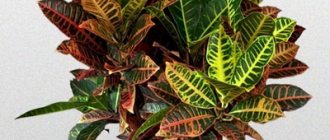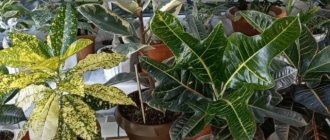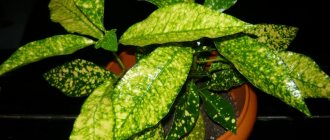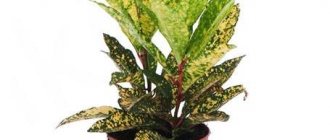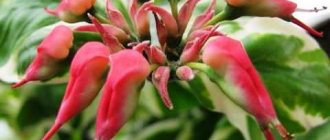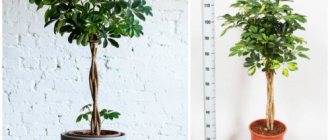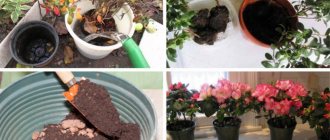Codiaeum attracts the eye with variegated leaves, colored yellow-green, pink or red. A healthy plant delights with a riot of colors all year round, but the plant is a picky plant. Therefore, you only have to neglect the rules of care once - and the leaves of the exotic flower will hang. How to properly care for a croton so that it is always in good health?
Description of croton, origin, features
The houseplant croton is also called codiaum; now these names are considered to be synonyms. But from a scientific point of view, the second one will be more accurate. Crotons are a genus of over a thousand species of tropical shrubs and trees. Their closest relatives, they belong to the same family Euphorbiaceae, are codiaeums. According to the latest data, there are only 17 species of evergreen plants in this genus. And only one of them, Codiaeum variegatum, is adapted to home conditions. It is his flower growers who are accustomed to calling croton.
Croton is a tropical plant, it is accustomed to warm and humid climates.
Codium is native to the tropical forests of Southeast Asia (common in India, Malaysia, Indonesia) and the islands of Oceania and Australia. The climate in these parts is mild, the temperature does not drop below +25, the rains are plentiful but short, and the soil is always slightly damp. Therefore, the plant fell in love with high humidity and very warm, even hot, air.
According to one version, the plant received the name croton from the ancient people who inhabited the Moluccas Islands (Indonesia). According to another, naturalist Carl Linnaeus gave it the name of the Italian city of Crotone, which in turn was named after the ancient Greek hero.
Croton (codium), like all representatives of the Euphorbiaceae family, has a milky sap. It is poisonous to humans and animals. Croton "milk" can cause vomiting, diarrhea, and skin irritation. Therefore, you must follow safety rules: wear gloves when starting work, and then wash your hands and tools. The plant should be out of reach of small children and animals.
In freedom, codiaum grows above 3 meters
In their natural environment, crotons grow up to 3 meters or more. Houseplants are rarely taller than one and a half meters, and there are compact forms up to 60 cm. As a rule, this is an upright bush with variegated leathery foliage. The shape of the leaf plate has many options: an elongated or very narrow oval, an ellipse with a pointed or rounded end, two or three blades. Some varieties of croton have spiral, wavy, or intricately curved foliage. Its color is no less whimsical. On one plant you can see different shades of green, as well as yellow, red, pink and purple, burgundy painting. The pattern and brightness of the ornament drawn by nature depend on the conditions under which the flower is kept and its age. The more light and the older the croton, the more interesting and rich the colors will be.
The older the croton bush, the more varied and interesting its coloring.
An adult croton can bloom with good care. But the inflorescences cannot compete with the variegated foliage. They resemble a brush and appear in the axils of the leaves, each with one to two dozen small whitish flowers. They are divided into male ones, consisting of stamens and similar pom-pom balls, and female ones, curved pistils. The flowers on the cluster are of only one sex, but they open at the same time. Flowering greatly weakens the croton, after which growth slows down for 3–4 months. Therefore, at home, flower stalks are usually removed.
Male croton flowers are balls of stamens, they are cute, but take a lot of energy from the plant
Croton has never been considered an easy species to grow. It has always had a reputation as a capricious and demanding plant. This luxurious beauty takes a long time to get used to a new place, can get sick immediately after transplantation, requires a lot of light and high air humidity all year round, and cannot tolerate cold and drafts.
It has become easier to grow codiaum (croton) at home; now there are devices that humidify the air and special lamps for plants
Previously, such requirements were difficult to meet. But now flower growers have accumulated a wealth of experience in growing the whimsical croton and are successfully using it. Plants and modern devices help fulfill the whims. To make the air tropically damp, you can use an electric humidifier or an indoor fountain. Short daylight hours will be lengthened by special lamps. But even with such technical support, the croton will not do without constant attention; it needs to regularly wipe the foliage, form a bush, protect it from temperature changes and pests. This plant is suitable for caring and caring gardeners.
Croton requires a lot of attention and care from the grower
Brief characteristics of the plant
In natural conditions, croton is a large spreading bush, reaching 3 meters in height. When grown in a pot, its dimensions are more modest: they rarely exceed 1.5 m even with scrupulous care. The culture looks beautiful, from a distance you might think that it is an artificial plant. According to the general classification, croton is classified as a decorative foliage group.
Because of its decorative effect, it is used to decorate large rooms: halls, lobbies, lobbies and offices. The leaf blades are of extraordinary beauty, with yellow spots and multi-colored veins, the intensity of which depends on the lighting. The shape of the evergreen plant resembles a small and neat tree, but forming its dense crown is not easy: it takes several years to create it. To keep Croton looking neat, it needs to be trimmed regularly.
Under natural conditions, the crop blooms, but its buds have no decorative value. When growing codiaum at home, care rules require removing the flower stalks. This is due to the fact that unpresentable flowering only takes away the strength of the plant and does not allow it to develop.
Interesting! Literally translated from Greek, the botanical name of the culture Codiaeum means “head”. This name has not taken root in Russian and is rarely used by flower growers. The name “croton” is more common, but its translation and decoding are unknown.
Indoor plant species and varieties
A single species, Codiaum variegatum, as well as its varieties and hybrid varieties, began to be grown as indoor plants. But they represent such a wealth of shapes and colors that other types were simply not useful.
Varieties of Codiaum variegatum:
- The narrow-leaved croton is equipped with long (about 20 cm) leaves, their width is no more than 1 cm. Yellow-golden strokes and specks are scattered across the green background.
- The appendage-like croton is variegated and green. Its leaves, wide at the base, narrow in the middle into a kind of petiole, and then expand again, forming a small leaf appendage at the end.
- Curly codiaum (crispum) has long, narrow, curled leaves. The greenery has stripes, spots, veins or a network of different shades of yellow. The brightest representative of the variety is Spiral with uniform turns of leaves.
- Lobed croton is distinguished by wide leaves divided into three parts. The central lobe is much longer and wider than the lateral ones. Yellow veins decorate the bright green of the leaf.
- Flat-leaved (platyphyllum) codiaum is a plant with large (up to 30 cm in length and 10 cm in width), oval leaves, their edges are slightly wavy.
- Oval-leaved (ovalifolium) with simple leaf blades in the shape of an elongated oval with a rounded end, rich yellow markings located along the veins.
- The tortoiseshell variety (tortile) is distinguished by leaves that are broad at the petiole and taper towards the tip. On an olive green background there are red and yellow stripes along the central vein and chaotic golden spots.
- Genuinum is a variety with solid oval leaves covered with a pattern of silver or gold color with a reddish tint. There are forms with small and ribbon foliage.
- Codiaeum variegatum pictum is the original form for most hybrid varieties. This is a shrub with a straight stem (up to 1 meter in height), which is covered with dense and hard leaves. They are painted with a pattern of bright yellow, red, pink spots on a green field.
The most famous varieties and hybrids of Codiaum variegatum pictum:
- Croton Petra is a branching stem bearing large, leathery leaves. Yellow veins, edges and dots are drawn on the main green background. The shape of the leaves is varied.
- Mrs. Iceton is a variety with wide, rounded leaves. Young plants have a cream pattern on them. With age, the color becomes more intense, becoming pink, yellow or red. There are forms of blood red or very bright yellow shades.
- The Excelent variety is easily recognized by its leaves, similar in shape to oak leaves. Young leaves, at the top of the plant, are yellow-green. At the base of the trunk - burgundy.
- Coroton Mammi is distinguished by narrow, small leaves. Their edges are slightly curved from the center. The color combines different shades of green, yellow, red and pink.
- The Zanzibar variety has long (about 40 cm) yellow-green leaves. They curve gracefully.
- Nervia is a variety with a colorful crown of bright green, lemon yellow and soft pink leaves. They are jagged with a well-defined vein in the center.
- Croton Tamara is a very rare variety. Oval leaves of medium size, bicolor. On the main dark green background, there are light green and white spots closer to the edges.
- Disraeli is a variety with lobed leaves. They are green-yellow above and red brick-colored below.
- Codium Black Prince with flat and wide foliage. The coloring is very original: the background is dark green, almost black, with red, yellow or orange markings.
What is Croton variegatum mix
Often, specialized stores offer plants called codiaum (or croton) variegatum mix. This is not a variety, but an indication that the batch contains specimens of this variety. Their color depends on the conditions and age of the leaves. So the same plant can look different. And even experts sometimes find it difficult to accurately identify the varietal identity of croton.
The name “Croton variegatum mix” can hide any variety
Video: introduction to crotons (codiaums)
Common varieties
There are natural varieties of variegated codiaum and artificially bred varieties. The latter are the result of selection work on mixing individual species. They are popular among flower growers because of their relative ease of care and small size, allowing them to be kept at home on a windowsill or as a tub plant. The list of popular varieties includes:
- Croton "Mrs. Iceton". The leaves are densely growing, transversely located along the entire length of the trunk. Young plates have a soft light green hue, while adults are painted in different colors: brown, burgundy, yellow, dark green. There are no boundaries between the stripes; it seems that the artist painted them using watercolor technique.
- Variety "Sunny Star". As it grows, it forms a neat, lush bush and readily produces side shoots even without pruning the main trunk. The leaves are leathery, their edges are rounded, the shade ranges from light green, lemon to rich yellow. Reddish spots form on mature leaves.
- Croton "Zanzibar". A rare variety with narrow lanceolate, curved leaf blades. The color is a mixture of all shades of green, yellow, burgundy and purple, with red central veins. Beauty is most evident in high-quality lighting.
- Codiaum "Tamara". A characteristic feature is the color of the leaves, which is unusual for crotons. They are green with a white edge. The shape of the plate is pointed, the leaves are densely located on the stem. The disadvantage of this variety is its slow growth; with good care, it grows only 5-7 cm per year.
- Croton "Gold Sun". The leaves are ellipsoidal in shape, color – green background with yellow dots. The height of specimens is up to 50 cm. The trunk is massive, easily formed into a standard.
- Variety "Petra". Popular variety with lobed leaves. The tree is well formed, forms a crown and grows quickly. The veins and edges of the leaves have a yellow tint, the rest of the plate is rich green, burgundy and red. With a lack of sun, the leaves turn green with white veins. High-quality lighting will help restore a natural look.
- Codeium "Excelent". A distinctive feature of this variety is its leaves. They are shaped like an oak, which is why people call the variety “oak-leaved.” Young leaf blades are yellow or green, beauty appears later. They turn purple, burgundy and deep red.
All of the listed varieties belong to the same genus, but differ significantly from each other in leaf structure, growth intensity and the process of crown formation. If you compare two different varieties with lanceolate and lobed leaves, it will be difficult to find similarities between them. The only unifying factor will be the multi-colored color and the presence of a characteristic pronounced middle vein.
Common types
Codeium from the Euphorbiaceae family reaches a height of about 1.5-2 meters. Croton is native to islands in the Pacific Ocean, where it is always warm and humid. Codiaum prefers tropical climates. There are many types of codiaum, but in home floriculture the most popular are Croton Motley, Mammy, Sunny Star and Crispam, as well as codiaum Tamara.
Codeium
Codiaum Mammi
This species is a variety of variegated. India and Malaysia are considered to be the birthplace of the flower. It has the shape of a bush, the leaves of the Mammi croton are large, painted in various shades. From yellow-orange, with red splashes, to golden with green streaks.
The Mammy codiaum flower is popular among lovers of these plants due to the unusual foliage. It is narrow and spiral-shaped, creating a specific curly crown.
Codiaum Mammi
Codiaum Variegatus Mix
This is the main species from which most forms are derived. Codiaum Variegatus has large leaves, reaching 30 cm. They are characterized by leatheriness specific to codiaums. The leaves are always brightly colored with pronounced reddish or greenish veins. Each plant is individual, representing a real riot of colors - green, yellow, red, orange, and in some cases, almost black.
Interesting! The codiaum will retain its outfit all year round for many years.
The description of the Varigatum Mix plant indicates that this is not a specific variety, but a whole batch of one variety. Depending on the conditions of detention and the age of the leaves, the codium flower can look completely different. Even experts are not always able to identify the croton variety in a pot labeled Variegatum Mix.
Codium Variegatum Mix
Codeum Sunny Star
Codium Sunny Star is represented by a subspecies of the plant, with a large number of shoots on the sides. The leaves are lanceolate-shaped, painted in a bright light green color, and the tips are yellow. The homeland of Sunny Star codiaum is the south-eastern part of Asia, islands in the Pacific Ocean.
This is an interesting plant with narrow leaves. Codium is a flower famous for the beauty of its leaves, but codeium blooms inconspicuously and very rarely. Mostly in the summer. On a small peduncle, which the bush throws out, there is an inflorescence in the form of a ball. A plant similar to this variety is Croton Gold Sun.
Codeium Gold Sun
Codium Crispam
The croton variety Crispam or Crispum is also called codeium curly. The flower got its name due to its narrow and curled leaves. On the green part of the leaf there are spots, stripes and veins of various shades of yellow. These crotons also have their own varieties. A striking representative of the curly codiaum is the spiral one, which has uniform curls of leaves.
Description of codiaum and plant types
Codium came to Europe from India. It is sometimes confused with croton due to the similarity of the leaves, but despite the fact that these plants are of the same family, they are completely different. Croton is grown for the needs of the medical and chemical industries, and codiaum is exclusively an ornamental plant.
External signs
This evergreen variegated shrub can decorate any home garden. Codium variegated and its varieties are grown indoors. The plant has the following external characteristics:
Fleshy, thick leaves with veins up to 40 centimeters in length.- The color of the leaf plate is very diverse. There are olive, dark green, light green, chocolate and orange shades.
- The leaves are oval, asymmetrical, pointed and lobed in shape.
- The inflorescences of codiaum are inconspicuous and small. The flowers are pale yellow and their shape resembles umbrellas.
- It has an erect stem and a strong root system.
The plant is striking with its variegated leaves. Sometimes they are twisted, wavy or with slight constrictions.
Plant species
The most common variety is Codiaum Motley, and the rarest is Sunny Star. The following varieties for home cultivation are distinguished:
- Codiaum Petra has large olive leaves with yellow veins.
- The Mammy variety has narrow red-green leaves, curled into spirals. This is a very bright, unusual flower that attracts attention.
- Codiaum Nervia has unusually shaped leaves that resemble oars. Young leaves are green with yellow veins. Subsequently, the leaves turn red and the veins turn brown.
- Codium Gold Sun. Home care should include abundant watering and constant darkening. It has narrow green leaves covered with yellow spots. In bright light, the leaves become beige in color.
- The magnificent Sunny Star attracts with its unusual coloring. Its spotted leaves are colored yellow and bright green.
- The rather tall variety Tamara has long leaves with white veins. The edging of the leaf plate is embossed, which gives the flower a special charm. The height of the bush reaches one and a half meters.
The most popular variety is Variegated Codium. In its natural environment its height reaches two meters. This variety has large, long leaves with orange veins. The leaf shape can be very different: oval, guitar-shaped or spiral. This variety has male and female inflorescences. In the first case, the inflorescences have a calyx and corolla, and in the second there are no petals.
Conditions for croton (table)
| Season | Lighting | Humidity | Temperature |
| Spring | Bright, diffused light. A small amount of direct sunlight is beneficial. They will make the color brighter. The best place to place croton is window sills in the east or west, south side, but at some distance from the window. From the hot midday sun it is necessary to shade | High, 70–80%. Spray the plant regularly (in hot weather and with the heating on, 2 times a day). Wash the leaves. Humidify the air around you in all ways:
| Moderate and slightly elevated. Optimally +20–25 degrees. In the warm season, you can take it out into the fresh air, but protect it from drafts, significant temperature changes and cold winds. |
| Summer | |||
| Autumn | Bright, diffused. Daylight hours must last at least 12 hours, otherwise the leaves will lose their variegated color. Provide artificial lighting. | Moderate, slightly reduced, + 18–20 degrees. Below + 17 is unacceptable. Do not place near heating appliances or cold window glass. Maintain an even temperature, without fluctuations. | |
| Winter |
Clean leaves are the key to health
Croton is a neat plant; it can get sick due to the fact that the leaves are covered with dust. Why is wet cleaning so important?
- Dust closes the pores on the leaves, and this makes air exchange with the environment difficult.
- The dusty film slows down the process of photosynthesis, the plant suffers from nutrient deficiency.
- Dust can contain and accumulate harmful substances.
- Pests may be hiding under the dusty layer.
Washing crotons with wavy or curly foliage requires patience, but is important for the health of the plant.
Therefore, at least once a week, take a soft damp cloth and wipe the croton, admiring the colorful patterns. It is better in the first half of the day so that the plant dries out before nightfall. To make cleaning easier, pre-spray your beauty.
For greater beauty, you can add gloss to the foliage. It is better to take polishing products in aerosol packaging. Or try traditional recipes. Polish the leaves with beer, a weak solution of vinegar or milk. Do not touch young foliage. And polish the adult one carefully, do not press hard, so as not to cause injury.
Leathery leaves look good after polishing
Florarium and croton
Croton lovers say that the most difficult thing is to ensure high humidity. It is not always possible to create tropics in an apartment in which a fastidious plant feels good. Croton will enjoy living in a home greenhouse - a florarium. It is easy to maintain the desired microclimate, including high air humidity. Making an open florarium is not difficult. You will need a container with a door or an aquarium made of glass or transparent plastic.
- Fill the container with drainage material (pebbles + charcoal), porous soil substrate with a high sand content.
- Plant tropical plants with the same care and maintenance requirements.
- Moisten the plantings, cover them with a lid or just glass, and place them in a warm and bright place.
- The florarium plants themselves create a favorable microclimate.
- From time to time, if condensation appears, ventilate the mini-jungle.
- Once every few months, give the plants a rain and clean the florarium: inspect the pets, remove damaged leaves, add substrate if necessary.
For a florarium, select plants with similar habits
The many-sided croton is an ideal plant for a florarium. To avoid problems with care, you can plant different varieties. Such a “kindergarten” will not be boring. Good neighbors for croton are ferns, arrowroot, fittonia, rheo, selaginella. Avoid planting succulents and cacti with them.
An indoor florarium is sometimes called a garden in a bottle. Its main difference from an open one is a container with a rather narrow neck that closes tightly. After planting, the bottle garden is watered only once, and then it is sealed and not opened. Plants live in a closed ecosystem. An indoor florarium is not the best choice for croton. Its leaves are too large.
Croton is suitable for growing in an open florarium; for a garden in a bottle it is large
Is it possible to grow a bonsai from codiaum?
Croton's patterned foliage will look great on a bonsai tree. This idea certainly dawns on flower growers. And such bonsai are grown. But with great difficulty and losses. Croton has several qualities that make it unsuitable for this:
- leaves are too large and heavy;
- the plant does not tolerate transplantation well, and for bonsai this is an annual operation;
- easily loses foliage due to care errors;
- a straight stem is difficult to form.
You can grow a bonsai from croton, but it is difficult, and the result will not always please you
Diseases and pests of crops
Croton is rarely attacked by pests because it belongs to the genus Euphorbia, all of which are poisonous. Most often, problems are associated with diseases and are caused by improper care and maintenance. When growing, the following problems arise:
- Anthracnose is a serious fungal infection that appears when flooded. It is characterized by the formation of red or gray spots on the back of the leaf. The fungus spreads through the cells of the culture and causes its death. Antifungal agents are used for control. You also need to clean the root system from rot.
- Drying of the tips of the leaf blades. Associated with non-compliance with humidity and watering regimes. It will not be possible to restore the condition of old leaves, but the indicators need to be restored to normal. If the plant is severely damaged, re-rooting is necessary.
- Brown spots on the outside of the plate. These are sunburns that occur when the crop is placed on southern windowsills in the summer without shading.
- Drying of the crown. Occurs at low temperatures. This is how the plant stops growing and developing.
- Root rot. The leaves become soft and fall off the trunk. You can save the bush if you promptly treat it with broad-spectrum fungicides.
Attention!
Loss of leaf color and disappearance of shine occurs when there is insufficient lighting and non-compliance with the feeding regime.
The Croton houseplant looks spectacular with proper care. If the basic rules of content are not followed, the culture loses its decorative value. With a lack of lighting, the variegation disappears and the leaves become dull. Failure to comply with the temperature regime and lack of regular watering can lead to its death.
Care
Codiaum has never been a plant easy to cultivate; it has always had a reputation as a very demanding and very capricious green pet. This exotic beauty takes a very long time to adapt to a change of place of residence, immediately after transplantation it can be sick for a long time, and needs good lighting and high humidity throughout the year. The flower does not tolerate low temperatures, cold drafts and dryness.
With the advent of home climate control equipment, maintaining a comfortable environment for plants has become much easier. Therefore, flower owners should take care of purchasing an air humidifier, air conditioners and phytolamps , which will create conditions in the room that are close to natural. But even with such support, codiaum requires constant attention, it needs to be properly cared for, protected from air currents, direct sunlight and temperature changes, it needs protection from pests, and also gratefully responds to periodic spraying of leaves, bush shaping and regular replanting .
Temperature
In order for your contact flower to feel as comfortable as possible, it is necessary to maintain the optimal temperature at +20.24 degrees Celsius. The extremely low temperature for it is considered to be +23 degrees during the dormant period (from November to February); if the room is cold, then life processes begin to slow down, and the plant does not have the strength for full growth and development.
Temperatures above +24 degrees are also unfavorable for this ornamental shrub, but its harmful effects can be compensated by increased air humidity parameters.
Drafts should be completely excluded, as well as staying near heating devices - in both cases, the codiaum begins to stretch, the leaf blades wither, and soon the plant may die.
Humidity
Full care of codiaum involves maintaining a given level of humidity. This figure should be 45% or more. If the air is too dry, you will have to put in a lot of effort to avoid yellowing and falling leaves; this problem especially often occurs in winter when the heating is turned on.
You can help a representative of the tropical flora if you turn on the indoor fountain near the flower from time to time, line the tray with moss and, of course, spray the leaves with a spray bottle. Such a shower will not only increase the humidity parameters around the codiaum, but will also stabilize the metabolic processes in the plant tissues.
Keep in mind that when spraying, water should not get on the ground.
Lighting
Codiaum responds very well to long daylight hours; it prefers brightly lit places, but the light must be diffused - under scorching sunlight there is a high probability of leaf blades getting burned.
That is why the optimal directions for arranging flowers are eastern and western . If the plant is grown on a southern windowsill, it will require additional darkening. On the north side, a flower can only fully develop with the use of additional lighting, otherwise the shoots begin to stretch, the leaves lose their variegation and richness of colors, and then completely fall off. The plant begins to wither and soon dies.
Usually, special phytolamps are used for illumination - they have the necessary yellow spectrum of light and at the same time do not create an increase in temperature around the plant.
However, if there is no special lamp, then an ordinary fluorescent lamp can help, but in this case it should be located at a distance of 50-60 cm from the flower.
Watering
The main requirement for caring for codiaum is good hydration from March to September. The plant needs abundant watering, which is done as the substrate in the pot dries. In the cold season, the activity of the plant subsides, so you need to water it less abundantly and irrigate it a little less often - you can wait a couple of days after the soil dries out.
The plant immediately signals a lack of water - the foliage becomes faded, loses its elasticity and wilts, however, excessive irrigation can also cause rotting of the roots, as a result the above-ground part of the flower does not receive enough nutrients and begins to dry out and wither.
For irrigation, you should use soft water, preferably settled for 2-3 days or filtered.
A couple of times a week, codiaum needs a warm shower or wiping the leaf blades with a soft, damp sponge.
Fertilizer
In spring and summer, simultaneously with watering, it is necessary to feed the flower. To do this, you can use ready-made complex preparations enriched with all the minerals, micro- and macroelements necessary for normal life of plants. Feeding should be done every 2 weeks.
During the dormant phase – in winter – the application of fertilizers can be suspended.
Molding
If you want your codiaum to have a beautiful crown, it must be pruned periodically; for a young plant, pruning is replaced by pinching. Trimming the top of the shoots stimulates the growth of the side shoots, which makes the crown dense and can be given the desired shape.
As a rule, the buds and flowers of codiaum do not have any decorative function, but only take on some of the vital nutrients and juices; they are recommended to be removed along with the leaves that have withered and lost their elasticity.
For pruning, use pruning shears or sharp sterile scissors, and after the procedure, the cut site is sprinkled with crushed activated carbon.
Codiaum. Growing problems:
- Croton sheds its leaves when there is insufficient watering or at low room temperatures or exposure to cold drafts.
- Dry leaf tips appear in rooms with too dry air.
- Leaves droop if the room is too cold and the roots of the plant are frozen, the plant stops consuming moisture.
- The lower leaves dry out - this is a natural process of plant aging.
- If the edges of the leaves dry out and brown spots appear, this indicates that the plant is frozen and the room is too cold.
- The leaves dry out and fall off if the plant does not have enough watering.
- Stopping growth indicates that the plant does not have enough light.
Views: 1,440
Trimming
This procedure allows you to form an aesthetic bush with a neat crown. Pruning is done in the spring. If the flower is young, you only need to pinch the top part. This will encourage branching. The crown of a mature plant is formed by pruning shoots and removing excess branches. To prevent the occurrence of fungal diseases, the cut areas are treated with crushed charcoal.
The separated parts can be used in crop propagation by cuttings.
Transfer
The young plant needs to be moved to a new container every year. It should be about 3 cm larger than the previous one. The flower is taken out along with the earthen lump and carefully moved into a new pot, trying not to damage the roots.
Mature plants should not be moved so often. The procedure is carried out after 2-3 years. The exception is cases where culture develops too quickly.
If the roots do not have enough space in the pot, which is why they become visible, then the flower should be moved to a larger container earlier than planned.
Pests and diseases
Preventing pest infestations is very simple. You just need to carefully inspect the plant during each watering and spraying.
If insects are removed in a timely manner , their population will never become so large that the plant will notice it.
Moreover, pests are usually afraid of codiaum because of its poisonous juice.
If somehow pests have taken over the plant, washing with soapy water and treating with a fungicide will help.
Frequent feeding and watering (without flooding) eliminates the occurrence of diseases.
Codiaum Peter can hardly be called a very capricious plant, however, it needs to be given attention.
If you follow the basic rules for caring for this variety of garden croton, it will delight you with its variegated foliage for many years.
How and with what to fertilize without causing harm?
Croton Petra responds well to feeding. In summer and spring, fertilizer should be applied twice a month; in winter, fertilizing should be reduced and carried out no more than once a month.
Experienced gardeners recommend using organic fertilizers or alternating them with mineral fertilizers. The application of mineral fertilizers in high doses leads to the growth of ugly leaves. Nitrogen applied in excess amounts causes loss of variegated color.
Reproduction methods
Indoor codiaum is propagated by seed or by cuttings.
Seed material must be fresh. To begin with, the seeds are poured with warm water (50-60 degrees) for half an hour, then taken out and left to swell for 24 hours, wrapped in a moistened napkin.
While the seeds are being prepared, make up a soil mixture. It is important that it is drained, nutritious, slightly acidic, with high parameters of water and air permeability.
The seeds are buried 1 cm into the substrate, watering is carried out using the bottom method through a tray until the first shoots appear. When the seedlings acquire 2-3 leaves, you can safely transplant the young plant into small separate pots.
Most often at home, the cutting method is used. To do this, cut a stalk 8-15 cm long from the top, wash it under running water so that all the milky juice is completely released, and then dry it under natural conditions for a couple of hours. After all the manipulations, the cutting is placed in warm water in order to root it.
To avoid rotting of the roots, you can add a little coal to the vessel, or you can tint the water with pharmaceutical blue. It is advisable to create greenhouse conditions in the container - cover it with plastic film or glass in order to maintain high humidity and an optimal temperature for germination of +25.28 degrees Celsius. To place the container, you should choose bright places, but such that they are not exposed to direct sunlight.
Rooting usually takes 2-3 weeks; as soon as the roots grow 2 cm, the shoot can be moved to a permanent place of residence.
Experienced flower growers advise propagating codiaum leaves ; to do this, they are cut into two parts, buried with cuttings in the ground and covered with a bag, periodically watering and spraying. After 2.5-3 months in a comfortable environment, the plant takes root and roots appear.
However, even in this case, it will not be possible to grow a full-fledged adult plant if there are no buds for shoots, which is why it is imperative to cut off a small section of the stem along with the leaf.
Sowing seeds
For sowing seeds, you should use freshly harvested seed material, since codiaum seeds lose their viability very quickly. Another disadvantage of this method is that plants grown from seeds have random characteristics and do not 100% inherit the characteristics of their parents. Therefore, seed propagation is most often used by breeders to obtain new varieties and colors.
Step-by-step instructions for sowing codiaum seeds
- Before sowing, the seeds should be kept in hot water at about +60 degrees for 30 minutes.
- After this, the seeds are left to swell in water for a day.
- Seeds are sown to a depth of no more than 1 cm. The containers should be covered with film or glass and kept at a temperature of at least +22 degrees until germination.
- After germination, the glass or film is removed.
- After the first true leaf has formed, the seedlings can be planted into separate containers.
Caring for young seedlings is exactly the same as for adult plants.
At home, an easier and more accessible method of propagation is by cuttings. In addition, plants grown from cuttings have all the characteristics of the mother plant from which they were harvested.
Rooting cuttings
For rooting, a part of the stem with 2 buds on it is enough. At least 1 healthy leaf is also left on the cuttings.
After cutting, the cuttings should be washed in warm water to remove the milky juice that appears at the cut site. You can root in constantly moist soil or in water.
When rooting in the soil, it is necessary to maintain the ground temperature of +23...+30 degrees; without bottom heating, such conditions are unlikely to be provided around the clock. In cooler water, roots will not form and the cutting may rot.
Rooting in water will take a long time - up to 2 months. The water should also be warm enough, +23…+25 degrees. For successful rooting, use root formation stimulants, such as Kornevin, Heteroauxin.
After the roots have grown at least 2 cm, the cuttings can be planted in the ground. After planting, rooted cuttings should be sprayed daily until the elasticity of the leaves is restored and growth begins.
Layering
Layering can also be obtained in a more conventional way, by pressing the stem to the ground and covering it with soil. To speed up the emergence of the root system, you can remove the bark from the lower part of the stem and again treat this place with root formation stimulants.
After new leaves begin to grow on the pressed shoot, the plant can be separated from the mother.
Air layering
The trunk of codiaum is often exposed, and the plant loses its decorative effect. This can be used to obtain planting material.
To do this, in June, at a distance of 10-15 centimeters from the top, a circular cut is made on the stem and the bark is removed.
The cut site must be treated with a root formation stimulator. You can wrap sphagnum moss around the cut area and wrap it with film on top to prevent the moss from drying out. The upper part of the film is loosely fixed so that the moss can be moistened.
The first roots will appear in a month, but the cutting can be cut only after the roots reach 5 cm in length, so that they can provide the leaves with moisture when separated from the mother plant.
The cuttings planted separately are placed in a shaded place for 2 weeks. At this time, the plant must be sprayed frequently so that it does not suffer from lack of moisture.
Secrets and difficulties of caring for codiaum at home
Codiaum is a very capricious and finicky plant. It must be grown only according to established rules. Otherwise, the flower begins to lose its decorative and aesthetic value.
Basic rules of care
The basic rules for caring for codiaum are presented in the table.
| Care criterion | Recommendation |
| Lighting | Sunlight in the morning and evening, at noon - bright diffused light. |
| Air temperature | Vegetation – 20-22℃; rest period – not lower than 16℃. |
| Humidity level | High level of humidity (from 75%). |
| Watering | Moderate. Frequency: every other day. |
| Top dressing | From April to November - 2 times a month, the rest of the time - 1 time a month. It is recommended to use complex mineral fertilizers for decorative deciduous plants. |
| Rest period | Winter. |
| Substrate | Turf soil + leaf soil + sand + humus in equal proportions. |
| Drainage | Expanded clay, small crushed stone, broken brick. |
| Flower pot | Deep with drainage and a tray for water drainage. |
Diseases and pests
Codiaum is susceptible to attacks by scale insects, aphids and spider mites. The infected plant is treated with a solution of any insecticide, for example, “Thunder”, “Grizzly”, “Fly-eater”. For heavily infected flowers, the treatment is repeated several times.
Codium diseases
This flower signals its problems through its leaves. Drying tips indicate a low level of humidity or air temperature in the room. Drooping leaves indicate waterlogging of the soil. If the air in the room is too dry, as often happens during the heating season, the flower may well shed all its leaves.
How to propagate and replant a flower at home
Young plants require annual replanting. Adult codiaums are replanted as the roots fill the pot space, but at least once every 3 years. Transplantation is carried out using the transshipment method. The remaining voids in the pot are filled with fresh soil.
At home, the flower can be propagated in three ways:
- cuttings;
- seeds;
- layering.
Note!
It should be noted that cuttings are the most common method of propagating codiaum. Moreover, the flower can be propagated using this method all year round. Layerings are done no later than 3 months before the planned transplant. It is recommended to sow the seeds of the plant in February.
Apical cuttings
You can obtain codiaum from cuttings in the following way:
- A large leaf is cut from the mother bush and placed in water for 1-2 hours (to drain the juice).
- Then the leaf is rooted in a peat-sand mixture (1:1), and the soil is abundantly moistened.
- A cap is placed over the cutting (a cut-off bottle made of transparent plastic is suitable for this).
Propagation by apical cuttings
Every day the cuttings are moistened and ventilated for about half an hour. Rooting occurs after 1.5-2 months. As soon as the cutting produces a couple of young leaves, it is replanted as an adult plant.
Layerings and seeds
Some flower hybrids branch. These species can be propagated by layering. To do this, the woody vine is pinned to the soil using a staple. The top of the vine should remain exposed to the air. The top section of the vine with the bracket is sprinkled with soil. When transplanting, the rooted vine is cut off from the mother bush, planting it in the ground as an adult plant.
In order to remove codiaum from seeds, you must proceed as follows:
- Before planting, the seeds are soaked in a growth stimulator for a day.
- Then they are sown on a sand-peat mixture (1:1). There is no need to bury the seeds. Simply trample them with your fingers.
- The soil with seeds is irrigated using a spray bottle. The container is covered with film.
Scheme for rooting croton using air layering.
Caring for seedlings is similar to the above-described care for cuttings during the rooting period. The first shoots appear 3 weeks after sowing.
Signs and superstitions
- It is believed that Codiaum (Croton) is a very energetic flower. Many believe that he does not allow people with negative energy into the house. The flower senses people with bad thoughts and protects people living in the same room from them. Croton affects order and stability in the home.
- It improves the efficiency of its owners who are indecisive, despondent, or pessimistic. Codieum gives self-confidence and removes all negative phenomena. People suffering from speech problems communicate better in a room where the plant is located.
- For people involved in art, the flower is useful for new ideas and plans. It is also good to have a plant in the workplace to harmonize business relations between employees.
Sources
- https://diz-cafe.com/rastenija/kroton-kodieum-uxod-za-priveredlivym-krasavcem-v-domashnix-usloviyax.html
- https://greensotka.ru/dekorativno-listvennye/kodieum-ukhod-v-domashnikh-usloviyakh.html
- https://stroy-podskazka.ru/kroton/kodieum/
- https://stroy-podskazka.ru/komnatnye-cvety/kodieum-petra/
- https://selo.guru/rastenievodstvo/sukkulenty/kroton-kodieum/vidy-kr/petra.html
- https://ogorodnikam.com/komnatnye-rasteniya/kodieum-petra/
- https://mvazonchik.ru/kodieum-petra-uhod-v-domashnih-uslovijah.html
- https://kaktus-sukkulent.ru/drugie-rasteniya/kroton-kodieum-populyarnye-vidy/
[collapse]
